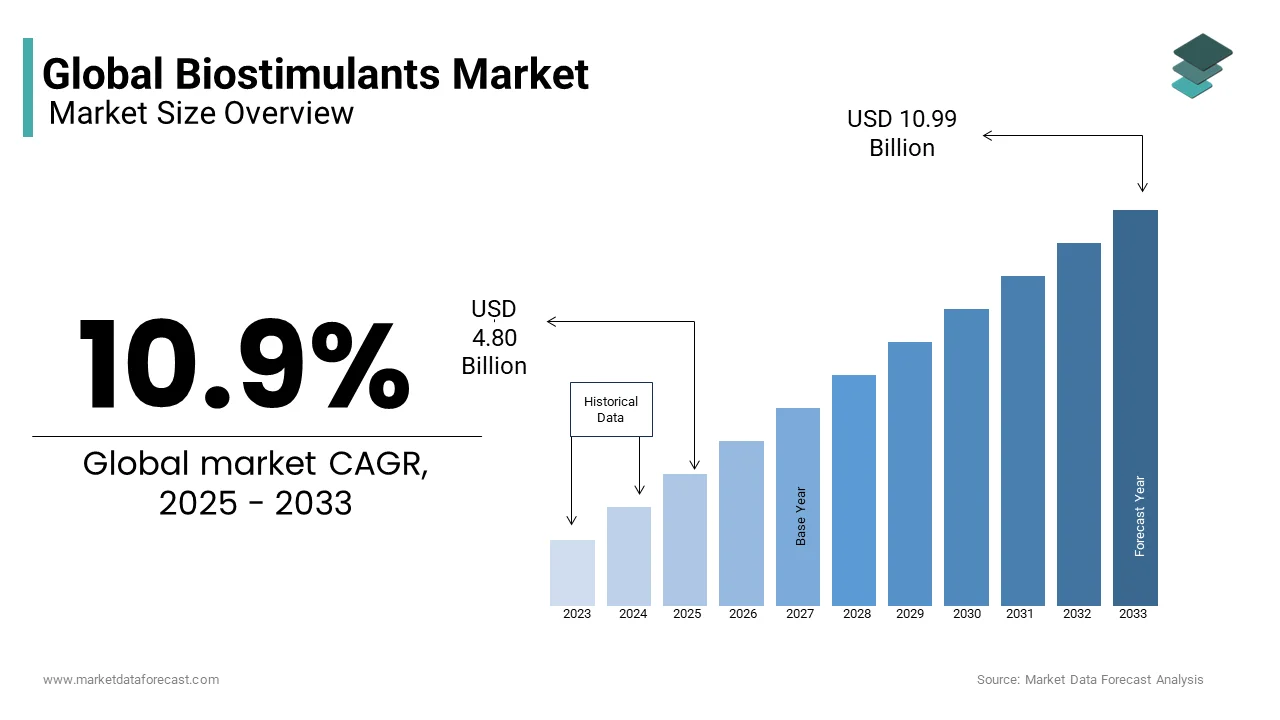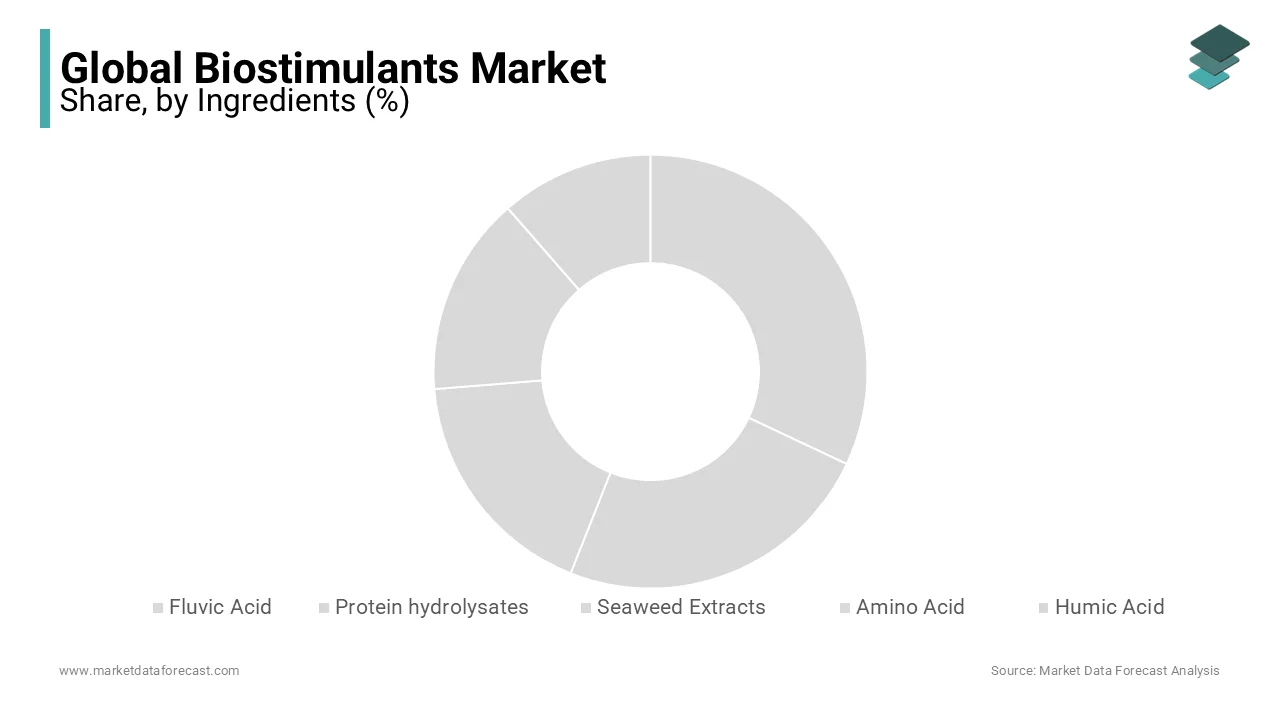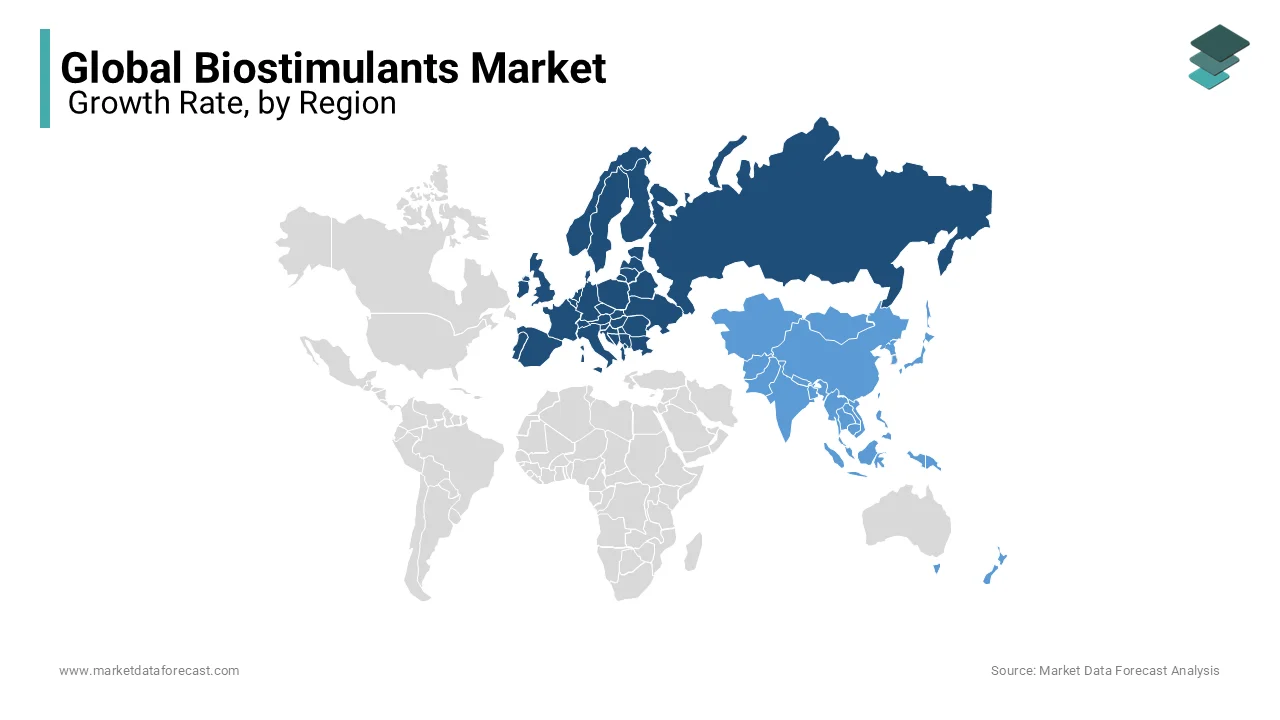Global Biostimulants Market Size, Share, Trends & Growth Forecast Report Segmented By Active Ingredients (Fulvic Acid, Protein Hydrolysates, Seaweed Extracts, Amino Acid, Humic Acid and Others), Application (Seed, Foliar and Soil), Crop Type (Fruits & Vegetables, Cereals & Oilseeds, Turfs & Ornaments and Others) and Region (North America, Europe, Asia-Pacific, Latin America, Middle East and Africa), Industry Analysis From 2025 to 2033
Global Biostimulants Market Size
The global biostimulants market was valued at USD 4.33 billion in 2024, and it is anticipated to reach USD 4.80 billion in 2025 from USD 10.99 billion by 2033, growing at a CAGR of 10.9% from 2025 to 2033.

Biostimulants are additives or microorganisms of natural origin that are applied to crops to improve nutritional efficiency, tolerance to abiotic stress, and crop quality. This fertilizer is most useful in promoting the assimilation, transfer, and use of nutrients. Biostimulants are applied to seeds, soil, plants, and other substrates to stimulate natural processes in plants. Its objective is to develop the efficiency of the use of nutrients in plants. Biostimulants improve crop yield, quality, vitality, and resistance to abiotic stress. They include various formulations of substances, microorganisms, and compounds that are applied to soil or plants. They favor plant development throughout the life cycle, from seed germination to crop maturation. Biostimulants differ from conventional pesticide solutions like pesticides and fertilizers. It works for the vitality of plants but is not designed for use against pests or diseases. They are applied to oilseeds and plants such as legumes, cereals and cereals, fruits and vegetables, lawns, and ornamental plants. There are several ways to apply biostimulants to plants, including foliar treatment, soil treatment, and seed treatment.
MARKET DRIVERS
The biostimulants market is primarily driven by the increasing need to support crop growth due to strong market demand for high-value-added crops around the world and abiotic stresses from changing weather conditions. The global biostimulants market is expected to see significant growth during the outlook period as global demand for green agricultural products increases. Factors such as increased ecological concerns due to the overuse of synthetic pesticides, increased need for high-priced crops, and reduced availability of arable land are supposed to drive growth in the global biostimulants market during the outlook period. Biostimulants help in the development of microorganisms, improve the absorption of nutrients by plants, increase antioxidant activity and reduce the stress of plants against the environment and various diseases. The growing awareness of the benefits of biostimulants, especially among farmers in the Asia Pacific region, is another factor driving the growth of the market under study.
The market is also growing as the adoption of sustainable farming methods increases. Increasing food consumption driven by population growth has prompted the agricultural industry to support the demand for biostimulants. However, some problems, such as loss of production and land degradation due to salinity, are some of the concerns of the agricultural industry. This has increased the demand for crop growth promoters. Excessive use of synthetic pesticides, reduced availability of arable land, increased demand for high-value-added crops, and increased ecological concerns driven by greater adoption of organic agricultural products are foreseen to boost the global market for biostimulants during the conjecture period.
The global biostimulants market is determined to expand at a significant rate during the foreseen period as global demand for green agricultural products increases. Biostimulants are used as effective tools for the development of sustainable agricultural products. Another important factor influencing market growth is the introduction of sustainable agriculture to protect the environment from adverse impacts. In addition, the increasing need for food and the limited availability of arable land as a result of the rapid growth of the world population are other engines of growth. Biostimulants improve crop yields to meet the growing need for food around the world. Other factors, including various innovations in the field of agricultural sciences and extensive research and development (R&D) activities, are estimated to further advance the market. The increasing focus on increasing the productivity and quality of crops is driving a hike in demand for biostimulants in the market. Furthermore, increasing demand for high-yield and quality crops and a high contribution to sustainable agriculture are expected to drive market growth.
MARKET RESTRAINTS
Lack of knowledge about the benefits of using biostimulants among farmers is estimated to act as a major impediment to the growth of the global biostimulants market. Besides, in addition to the limited knowledge of these substances and the high cost of research and development, they also hinder the growth of the biostimulants industry. Increasing government regulations and restrictions on the use of chemical pesticides limit the use of chemical fertilizers and stimulants worldwide, and the use of biofertilizers is further encouraged.
REPORT COVERAGE
|
REPORT METRIC |
DETAILS |
|
Market Size Available |
2024 to 2033 |
|
Base Year |
2024 |
|
Forecast Period |
2025 to 2033 |
|
CAGR |
10.9% |
|
Segments Covered |
Based on ingredient, Application, Crop Type, Region |
|
Various Analyses Covered |
Global, Regional and Country Level Analysis, Segment-Level Analysis; DROC, PESTLE Analysis; Porter’s Five Forces Analysis; Competitive Landscape; Analyst Overview of Investment Opportunities |
|
Regions Covered |
North America, Europe, APAC, Latin America, Middle East & Africa |
|
Market Leaders Profiled |
Arysta LifeScience, Biolchim S.p.A, Biovert SL, BASF, Stollerare, ILSA S.p.A, Italpollina, Bayer, Koppert B.V., Desarrollo Agrícola y Minero, and Agrichem |
SEGMENTAL ANALYSIS
By Application Insights

The world market for biostimulants has been segmented into oilseeds and legumes, landscape, fruits and vegetables, grass, grains and cereals, and ornamental flowers. In terms of sales and volume, the fruit and vegetable segment had a significant share of the global market in 2020 is estimated to expand at a great pace during the projection period. The cereals and grain sector is also expected to expand significantly in this period.
REGIONAL ANALYSIS

Europe dominated the global biostimulants market in 2020. This region is anticipated to create favorable opportunities soon. The application of strict regulations on the approval of pesticides in Europe, which cause the harmful effects of chemical-based agricultural products, will drive demand for biostimulants. The growing need for organic food is expected to increase the demand for biostimulants in Europe between 2021 and 2027. During the prediction period, Germany led the biostimulants market in Europe, followed by France and Italy. The Asia Pacific region is expected to witness promising growth during the forecast period due to the presence of several agriculture-led economies such as India, China, and Australia. Asia Pacific countries vary widely in income levels, spending capacity, and food consumption habits. The agricultural sector in the region is showing steady growth, and the population is highly dependent on the agricultural sector. This provides profitable growth opportunities for the biostimulants market.
KEY MARKET PLAYERS
Key players in the global biostimulants market include Arysta LifeScience, Biolchim S.p.A, Biovert SL, BASF, Stollerare, ILSA S.p.A, Italpollina, Bayer, Koppert B.V., Desarrollo Agrícola y Minero, and Agrichem, are playing a dominated role in the global biostimulants market.
RECENT HAPPENINGS IN THIS MARKET
- In February 2019, UPL (India) acquired Arysta LifeScience Corporation (USA), which is part of Platform Specialty Products Corporation (USA). The acquisition allowed the company to expand its presence in the biology market and expand its geographic footprint.
- In April 2018, BASF SE agreed to acquire an additional seed and crop protection business from Bayer. This agreement allows the company to strengthen its crop protection portfolio and enter the seed market.
- In May 2018, Arysta Lifescience acquired Etec Crop Solutions, which is a New Zealand-based company. Through this acquisition, the company aims to improve its application in the specialty sector through the innovation of phytosanitary products and biostimulants.
MARKET SEGMENTATION
This market research report on the global biostimulants market is segmented and sub-segmented into the following categories.
By Ingredients
- Fluvic Acid
- Protein hydrolysates
- Seaweed Extracts
- Amino Acid
- Humic Acid
By Application
- Seed
- Foliar
- Soil
By Crop
- Fruits And Vegetables
- Cereals And Grains
- Turfs And Ornaments
By Region
- North America
- Europe
- Asia Pacific
- Latin America
- Middle East and Africa
Frequently Asked Questions
what is the CAGR of global biostimulants market?
The size of the biostimulants market is expected to grow at an annual progression rate (CAGR) of 10.9% between 2025 and 2033.
what are key players involved in biostimulants market?
Key players in the global biostimulants market include Arysta LifeScience, Biolchim S.p.A, Biovert SL, BASF, Stollerare, ILSA S.p.A, Italpollina, Bayer, Koppert B.V., Desarrollo Agrícola y Minero, and Agrichem, are playing a dominated role in the global biostimulants market.
What segments are in the global biostimulants market?
Segments covered in the global biostimulants market are ingredients, applications, and crops.
Related Reports
Access the study in MULTIPLE FORMATS
Purchase options starting from $ 2500
Didn’t find what you’re looking for?
TALK TO OUR ANALYST TEAM
Need something within your budget?
NO WORRIES! WE GOT YOU COVERED!
Call us on: +1 888 702 9696 (U.S Toll Free)
Write to us: [email protected]